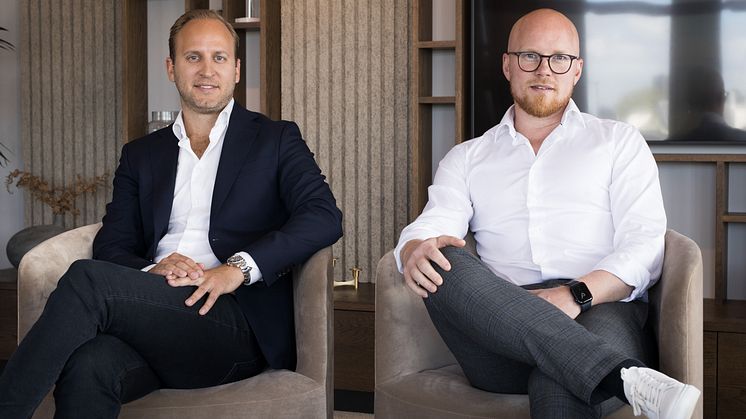
Press release -
Digital Transformation with Sigma Technology
Over the past years, Sigma Technology has been actively involved in the digital transformation of organizations and consulted a vast number of companies just contemplating it. Based on the most common cases, we have formed a perspective on what the actual digital transformation really implies. Although the term ‘digital transformation’ has become a catchword embracing far too many meanings and processes, many companies have yet to explore the full potential of digital transformation as a way of building a bridge between today and a better tomorrow.
What drives digital transformation? How to roadmap and perform these changes? What domains must be assembled to enable the transformation and challenge the status quo? To answer these and other constantly arising questions, we talked to Nermin Biscevic, VP of Sigma Technology Transformation. Sigma Technology Transformation is based in Malmö, Sweden, and is part of the Sigma Technology Group. The company’s essential vision is to help clients digitally enable their businesses by providing key competencies in software development, service design, and strategy.
There are thousands of definitions of the term ‘digital transformation’. Most commonly, it implies a paperless office, processes automation, or the so-called digital maturity of a business. How do you define digital transformation?
The missing word in the term ‘digital transformation’ is business. We tend to link digital transformation with technological change and visualize it by referencing such companies as Uber and Airbnb. These companies were born to go digital; their entire business model is a digital experience that meets customer demands. To us, digital business transformation means becoming digital at the core by embracing a holistic approach to changing the way your organization thinks, organizes, operates, and behaves.
What types of organizations and industries benefit most from the digital transformation?
In our opinion, established companies and the public sector will benefit most by adopting a digital-first approach. Through the years, we have learned that this mindset backed with a cultural shift in an established organization will increase customer value and drive effectiveness through a dynamic and changing realm we are a part of.
Jane McConnel, in her article “The Company Cultures That Help (or Hinder) Digital Transformation,” concludes that digital transformation has created a unique marketplace full of significant challenges and opportunities [1], as organizations must contend with nimble competitors who take advantage of the low barrier to entry that technology provides [2].
Do you agree with the statement? In your experience, what challenges and opportunities most commonly accompany this conversion process?
This statement is certainly true, perhaps especially in the retail, fintech, and service sectors to name a few. If you, however, apply the statement to the manufacturing, automotive, or medicine, and pharmaceutical sectors, where supply chains, legacy cycles, and long innovation and development cycles play a huge role – then the statement isn’t as easily adopted. Providing a competitive marketplace that brings service providers and customers together often has a low barrier through technology, but if you don’t bring true value to the customer, technology only becomes a means to an end. What you really need is digital business transformation, which will help companies rethink how their businesses operate. As a modern digital transformation agency, we see customer behavior, business models, the technological revolution, and cultural and societal change as key building blocks for evolving an organization.
How do companies usually start their journeys to digital transformation? What goals do they pursue?
This varies depending on the company, organizational maturity, and the business model, of course. The preferred way we at STT support is the adoption of the ‘start small and scale’’ approach. Everything is a hypothesis unless you can prove it. The most effective and outcome-based approach is to model a couple of hypotheses and run them by your customers. The old days of the ‘golden bullet’ monolithic approach when companies would select one product vendor that would solve it all with a one-size-fits-all solution are almost behind us.
Can you provide an example of the “start small and scale” approach?
The “think big, start small, and start now” approach is about getting out of the start pits and converting ideas into actions by taking a hypothesis about a specific problem and applying an MVP-based approach. A minimum viable product or MVP is a version of a product with just enough features to be usable by early customers who can provide feedback for further product development. The ‘start small and scale’ approach is a good way of validating the hypothesis without going into a lengthy development process. Most companies are well aware that innovation can be increased by applying this approach, but internal processes and the lack of an agile mindset create a slow pace and generate defensiveness. The agile mindset of getting out of the start pits and testing something is the true challenge for established players.
What are the main domains of digital transformation within the organization, and what skills does the team need to succeed in it?
I think the premise of the question must be reformulated back to the definition itself. Digital business transformation at its core is about changing the way an organization thinks, organizes, operates, and behaves. It’s about generating a cultural change and creating a mindset rather than diving into processes and rethinking skills, although these elements eventually become part of the change itself. In this case, an organization and a team that has passed this transformational journey get a breadth and diversity of proficiency in the interrelated domains of technologies, data analytics, and business management. Only the coexistence of these three, as part of a larger whole, makes it possible to reach the stepping-stone to digital business transformation.
While we were preparing for this interview, we got the impression that digital transformation as a growth-oriented play is not always on the agenda when it comes to digitalization and looks more like a defensive play. What do you think?
Change must come from the inside, and a strong legacy can often swing both ways. Innovation and change are essential goals and companies with a strong legacy struggle to keep up because of rigid processes, inside-out thinking management that doesn’t cope fully with rapid changes of the world outside, the investment challenge with quarterly shareholder expectations, and a general ineffectiveness that has accumulated over time.
Take the automotive industry as an example. Ten years ago, there weren’t many established original equipment manufacturers, such as Daimler, BMW, or FCA, that really thought that electric vehicles would come to dominate customer demand and tilt the entire industry just a few years later. The climate crisis triggered a movement where regulations followed that started to come into play more effectively than before, and many of the established players were forced to reallocate their resources to keep up with a player like Tesla (the same Tesla that was close to going bankrupt at the time). A defensive mindset along with an inside-out worldview put most of them on a path to actual survival, which wasn’t something any of these companies could imagine just a short decade ago.
Can you share your most remarkable story of digital transformation? What impressed you most about it, and what conclusions can you draw?
I am proud to be surrounded by impressive talent at our new Sigma agency. Many of the people here had worked together earlier, and we all took the opportunity of joining forces to build the company we desired here at Sigma. One key story was when the key players in the team were asked to scramble and help a certain customer that was launching an all-new brand. The request was to help the customer put together a nimble product and price engine for a rapid and global go-to-market strategy. Within a few weeks, we had an MVP (minimum viable product) on hand that the customer was able to use. The ‘start small and scale’ approach was at the core of the project, which demonstrated the power of an adequate hypothesis and a talented team that was fit for the purpose.
What advice can you give to companies that are just underway with digital transformation? What anti-patterns should they be forewarned of?
You should try to unpack your business model and start at the back of the problem by asking two very simple but imperative questions. 1) Who are you trying to help? and 2) What value will this bring to your customers and to you as a company? If you are satisfied with the answers, ask someone to corroborate your hypothesis outside your core team, preferably someone who is familiar with the customer or the problem you are trying to solve. It can be back-office, or someone in finance, shipping, and so on. The key is to confirm your hypothesis. Once you have performed those simple tasks, you should invest a day or two into a business canvas modeling session to visualize your business. One way of painting this is like this. Imagine you are preparing dinner for your family. Instead of going to the grocery store, open your refrigerator and look inside to see what you have at your disposal. Chances are you will save both time and money and also be able to ease your family’s appetite. The key takeaway is that you should try something and be okay with the fact that what first seems relevant isn’t always very innovative. You should always put your customer’s needs at the center and use them as your primary motivation and input value.
Final thoughts
Digital transformation is a profound undertaking, aiming to make an organization “digital” at its core. On the one hand, this process embraces far more domains rather than only implementing and leveraging technologies, it transforms the way how the organization thinks, organizes, operates, and behaves. But, on the other hand, digital business transformation is an organic process of responding to the changes within markets, industries, and society, enabling one to stay afloat and operate the business in a new environment and conditions.
For example, the COVID-19 outbreak has forced organizations to adapt to a new ‘’normal,” look ahead, consider significant changes, and swiftly start implementing them. WFH (work from home), growth in online interactions between a business and a customer, and unsettled future caused the emergence of such trends in 2021 as:
- development and implementation of the contactless solutions to reduce the f2f interaction;
- implementation of the VR/AR solutions;
- increased demand for high-speed, high-volume data communication and network upgrades;
- investment in data analytics and business intelligence solutions to predict the uncertain future and make data-driven decisions;
- switch towards omnichannel interaction between businesses and customers;
Thus, we see a transformation as an ongoing process highly influenced by many internal and external, predictable and unpredictable conditions. Companies that react to these changes faster succeed and leave the competitors far behind. The “start small and scale” approach allows them to confirm or disprove the hypothesis without going into a time-consuming development process.
Want to learn how your company can benefit from the digital transformation and implement the emerging trends? Contact nermin.biscevic@sigmatechnology.se for the consultation.
Topics
Categories
Sigma is a leading consulting group with an objective to make our customers more competitive. Our means is technological know-how and a constant passion for finding better solutions. In total we are 3,600 employees in nine countries.
Sigma is owned by Danir, held by the Dan Olofsson family.

